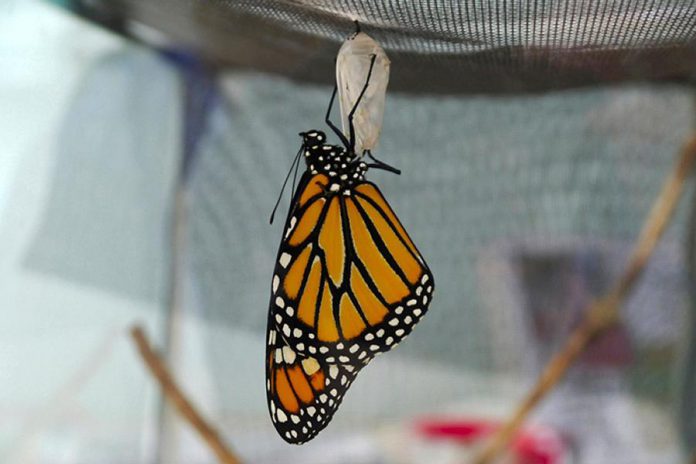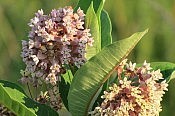
We’ve been watching a miraculous insect transformation here at the GreenUP office over the past couple weeks, which has been getting quite exciting during the last day or two.
Our Marcy Adzich and Carolyn Ross have been busy rearing monarch butterflies from caterpillar to chrysalis to fully fledged butterfly. The caterpillars were gathered from several locations around the area including Brighton, Coe Hill and right here in Peterborough.
The caterpillars were brought back to the office where they were carefully placed in a netted enclosure along with an ample supply of milkweed, the plant that they rely on for survival.
It’s during the caterpillar stage that monarchs do all of their growing. They begin life by eating the eggshell, which they just emerged from, and then move on to the plant on which the eggs were laid.
Once the caterpillar has become too large for its skin, it molts, or sheds the skin.
At first, the new skin is very soft, and provides little in the way of support or protection. The new skin soon hardens and molds itself to the caterpillar, which often eats the shed skin before continuing its milkweed diet. The intervals between molts are called instars, of which monarch caterpillars go through five.
It wasn’t long before our caterpillars began their impressive transformation. After gorging themselves on milkweed, one-by-one, over a period of a few days, they began to hang from the top of their enclosure and transform into a green chrysalis.
Shedding their black, yellow and white stripped skin, a lime green creature (pupae) emerged, which quickly hardened and transformed into a chrysalis. The chrysalis hangs from a silk pad spun by the caterpillar just before. Soon, the top of our enclosure was home to 15 tiny green pods, each containing a caterpillar undergoing a dramatic transformation.
The real magic started happening over the weekend as the beautiful butterflies began emerging from their chrysalises. Slowly wiggling free, the butterflies cling to their former home, allowing their wings to dry and stretch out before finally taking flight.
The primary job of the adult stage is to reproduce, mate and lay eggs that will become the next generation of butterflies. Females begin laying eggs right after their first mating, and both sexes will mate several times during their lives. There are typically four generations of monarchs over the course of a breeding season.
Amazing Life Cycle of a Monarch Butterfly
Mating aside, GreenUP’s butterflies have an extra job, and it’s not and easy one. They’re the final generation for this year and will be faced with the daunting task of migrating south to overwintering grounds in central Mexico when released. Here, they will cluster together, suspended in trees, waiting out the long winter in the north. Sadly, many won’t safely make it there and back.
Before being released, the butterflies will be tagged with a unique identifying code which will allow them to be tracked if found. The code will identify where they were released, which helps researchers better understand why these beautiful winged creatures which are in sharp decline.
The harsh reality is that monarchs are vanishing, and fast. This year alone we’ve seen an estimated 90% drop in the number of monarchs in eastern North America — a trend that we must reverse if we want future generations to enjoy them.
Why is there such a sharp decline in monarchs? It all comes down to milkweed. Monarchs depend on milkweed for both food and breeding and, in recent years, there’s been less and less of it. This is especially true in the United States where milkweed is killed en masse with herbicides in agricultural areas.
To flourish, monarchs need a “milkweed corridor” which extends from their northern range in Ontario, all the way along their migration route through Texas and into Mexico. You can do your part to help the monarchs by planting milkweed in your backyard. This helps to complete the northern end of the corridor.
Locally, GreenUP is helping in the efforts to save the monarchs through a couple of different means. Through our work at GreenUP Ecology Park, we’ve sold hundreds of milkweed plants, which are now growing throughout the Kawarthas. Tagging butterflies is the second part of our efforts, which we hope will help this important species recover and flourish for generations to come.



























